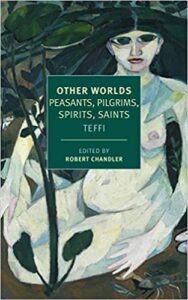Other Worlds: Peasants, Pilgrims, Spirits, Saints by Teffi, translated by Robert Chandler and Elizabeth Chandler
New York Review Book Classics 2021
ISBN 978-1681375397
Available: Paperback, Kindle ( Bookshop.org | Amazon.com )
Nadezhda Lokhvitskaya (1872-1952), known as Teffi, wrote distinctively Russian short stories drawing on her culture and its folklore and legends. These intriguing stories demonstrate Teffi’s ability to show how the supernatural coexists with the commonplace in the lives of ordinary country folk struggling to deal with the deprivation, superstition, dangers, and evils of their place and time.
Teffi’s characters are people who have seen it all and expect the unexplainable to happen. They are deeply spiritual but not necessarily religious. They have an eerie insight into the ways that supernatural good and evil touch human life. They are also preternaturally aware of the strange and frightening signs that tell them certain human beings are not what they seem and that unusual incidents are not random and harmless but are warnings, and even evidence, of hazards that must be confronted or at least recognized. Teffi’s characters do not live in a relatively stable world that is knocked out of shape by horror; they live in the midst of it – so much so, that its existence is chillingly normalized.
The stories in this collection, except for the first few, are built around characters and settings that feel sinister and menacing. In “Shapeshifter,” a doctor is thought to be “some sort of were-creature” whose “big stone house” was the site where a girl had previously been confined alive in a wall, and ten banknote forgers had been suffocated in the cellar to keep them from being found by the authorities. A woman experiencing a “Wild Evening” takes shelter at an old monastery that local children’s nannies use as a threat to keep their little charges in line.
In “Witch,” a couple struggles to be free of a servant who is said to have secured her job indefinitely by ritually burning scraps of paper and “blowing smoke” up the chimney. A priest’s vampire child threatens people’s safety in “Vurdalak,” and the “House Spirit” is up to its traditional tricks that might have to be taken as a serious warning against evil this time. In “Leshachikha” we hear “a kind of story that simply doesn’t happen anymore” about a widowed count with a “hard, yellowish nail of extraordinary length” who has a “malevolent” daughter with very odd ways. Several other tales focus on traditional Russian characters and their familiar stories: the house spirit, the water spirit, the bathhouse devil, the rusalka, and shapeshifters of all sorts, including those in the form of dogs, cats, and “she-wolves” (who are actually women who have been confined for far too long by controlling husbands). Even the famous Baba Yaga makes an appearance.
The Foreword, Afterward, and additional notes on Russian names and translation methods are helpful to readers who are unfamiliar with Russian folklore and tradition. However, some of the translation choices, such as mirroring period dialect in English, are distracting and negatively affect the mood and tone of the stories. Nevertheless, this collection is a blast from the Russian past that suggests, in an unsettling way, that perhaps these old stories are the best, because they come closer to revealing the often discounted darker truths of life we dismiss as old fashioned ways of perceiving reality. Recommended.
Reviewed by Nova Hadley





Follow Us!